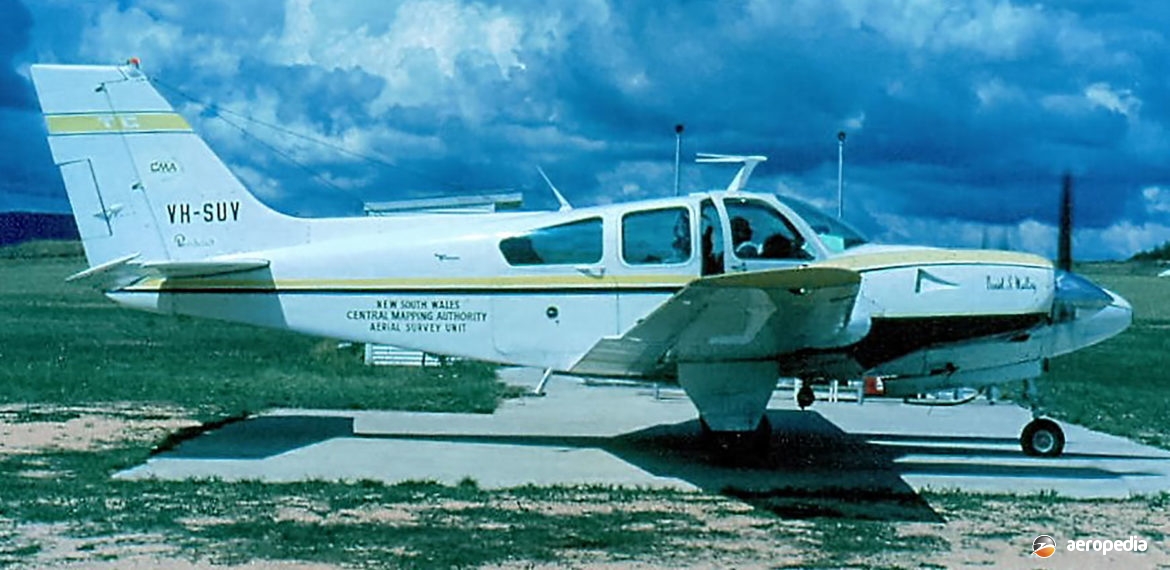Photograph:
Beech Baron 56TC VH-SUV (c/n TG-53) at Bathurst, NSW in March 1982 (David C Eyre)
Country of origin:
United States of America
Description:
Light twin-engine business and executive aircraft
Power Plant:
Two 213 kw (285 hp) Continental IO-520-C six-cylinder horizontally-opposed air-cooled engines
Specifications:
- Wingspan: 11.55 m (37 ft 8 in)
- Length: 8.59 m (28 ft 2 in)
- Height: 2.89 m (9 ft 5 in)
- Wing area: 18.50 m² (199.2 sq ft)
- Max speed: 389 km/h (242 mph)
- Cruising speed at 75% power at 2,134 m (7,000 ft): 374 mph (232 mph)
- Cruising speed at 3,048 m (10,000 ft) at 45% power: 291 km/h (181 mph)
- Stalling speed flaps up power off: 124 km/h (77 mph)
- Stalling speed undercarriage and flaps down: 107 km/h (67 mph)
- Rate of climb at sea level: 509 m/min (1,670 ft/min)
- Service ceiling: 6,675 m (21,900 ft)
- Take-off roll: 182 m (596 ft)
- Landing roll: 265 m (868 ft)
- Range at 45% power with reserve: 1,839 km (1,143 miles)
- Empty weight: 1,179 kg (2,600 lb)
- Useful load: 726 kg (1,600 lb)
- Loaded weight: 2,404 kg (5,300 lb)
History:
The Beech Baron series was developed by the Beechcraft Corporation as a successor to the Beech Travel Air and Twin Bonanza series. The prototype flew for the first time on 29 February 1960. More than 2,500 examples have been built in a variety of models, and production continued for some years. The basic models built included the 95-B55 with seating for four or six; the E55 with 213 kw (285 hp) Continental engines; and the Model 58 with similar engines but with a lengthened fuselage for more comfortable accommodation for the six persons on board. The range was extended after some years by the addition of the Model 58P with a pressurised cabin and 242 kw (325 hp) Teledyne Continental TSIO-520 engines; and the Model 58TC with similar power plants as the Model 58P but without the pressurisation.
Initial model was the 95-55 which was a refinement of the Beech Travel Air fitted with two 194 kw (260 hp) Continental IO-470 six-cylinder engines, deliveries of production machines commencing in 1961 and 190 having been sold by the end of the first year. In 1962 the A55 appeared, this having some improvements including an increase in flap area, a revised fin and rudder, and a sixth seat as an option. In 1964 the B55 appeared with an increase in max take-off weight to 2,268 kg (5,000 lb), a lengthened nose and optional three-blade propellers. This model continued in production for some years, the only major change being the increase in weight to 2,313 kg (5,100 lb). The US Army received 65 of these as the T-42A Cochise for instrument training, and five were delivered to the Army of Turkey.
A more powerful variant was announced in 1966, this being the C55 with 212 kw (285 hp) continental IO-520 engines, a lengthened nose and weight increased to 2,404 kg (5,300 lb). Production of this model was 451 examples when the slightly revised D55 appeared in 1968, of which 316 were delivered, the E55 in 1970 with 434 delivered, and eventually the turbo-charged models which first appeared in 1967.
The 56C with turbo-supercharged engines had 231 kw (310 hp) TSIO-520L engines and featured some structural changes to permit greater loads to be carried in the baggage compartments and in the cabin, total useful load being increased to 1,071 kg (2,360 lb). This model also had a two-stage propeller governor that provided an additional 100 rpm ‘burst of power” automatically during single-engine operations. Fuel capacity was also increased by 92 litres (20 Imp gals). In 1971 the A56TC was released, of which only 12 were delivered, and this model had 283 kw (380 hp) Lycoming TIO-541 engines and a weight of 2,717 kg (5,990 lb).
Like the lower powered Travel Air, the basic design of the Baron’s airframe was similar to that of the original single-engine Bonanza. The fuselage, of semi-monocoque construction, closely resembled the Bonanza, with the addition of a new nose and tail sections. The wing structure was of similar design, modified to accommodate two engines. The Baron was introduced to the range in 1961 with 119 kw (160 hp) Continental IO-470-L fuel-injected engines, a pilot and four passengers, the aircraft having a cruising range of 1,762 km (1,095 miles) with 45 minutes reserve. In its first year of sale it established a record as the best selling twin-engine aeroplane in the USA.
The first Baron seen in Australia was VH-DHA (c/n TC-393), an A55 operated as a demonstrator by the importer, which later became VH-CLT, whichas followed by VH-CLL (c/n TC-153) for Connellan Airways, this aircraft later becoming VH-UPJ.
A total of 1,201 examples of the Model 55 had been produced when production of this model ceased in 1983. The Model 58 remained in production but was produced as the Raytheon Beechcraft Baron, a total of 28 being delivered during 2005.
Two Australian pilots were credited with 32 world records as a result of their round-the-world flight in August 1971 in a Baron. Messrs T K Brougham and R N Dickeson of Whyalla, SA were credited with the records by the Federation Aeronautique Internationale (FAI) in Class C1-d aircraft weighing between 1,750 kg to 3,000 kg (3,858 lb to 6,614 lb) in a Baron, averaging 318.28 km/h (197.77 mph) for the 125 hours 57 mins flight from Darwin, NT to Rabaul in New Britain, Bucholz in the Marianas, Honolulu in Hawaii, San Francisco in California, Toronto in Canada, Gander in Newfoundland, London in the UK, Athens in Greece, Bahrain in the Middle East, Bombay in India, Singapore and return to Darwin.

